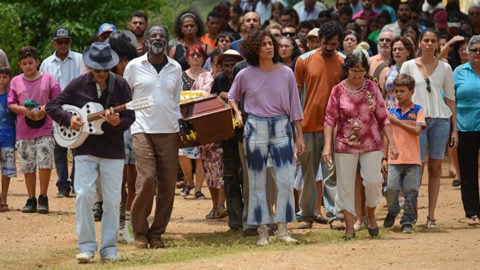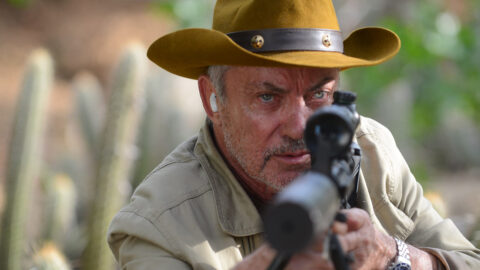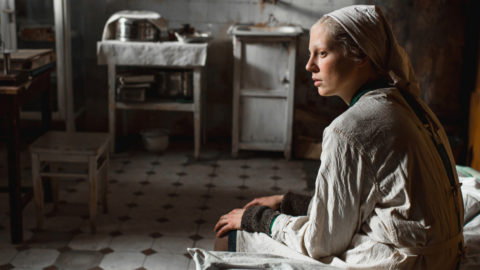Interview: Kleber Mendonça Filho and Juliano Dornelles
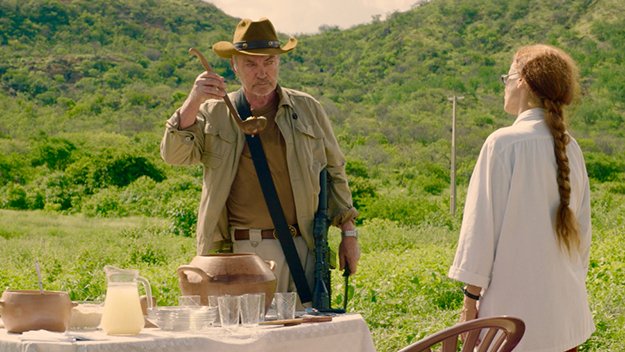
All images from Bacurau (Kleber Mendonça Filho and Juliano Dornelles, 2019)
No film in Cannes this year made it clearer that whether you see beauty or ugliness largely depends on where you steer your gaze than the audacious Bacurau, by the Brazilian filmmakers Kleber Mendonça Filho and Juliano Dornelles. Bacurau takes place in Brazil’s sertão, or backcountry, which in cinema thus far has been represented mostly as wild, bewildering, and parched—Brazil’s Wild West. In the film, Bacurau, an imaginary small community in this isolated terrain, becomes a target of a mysterious, heavily armed, and deadly group of foreign white tourists. When a ferocious confrontation ensues, the Bacurauans defend their own.
If there is deliberate ugliness in Bacurau, it comes mostly from the invaders’ vicious assault. Yet there is also staggering beauty in the place: not just of the sertão, which Mendonça Filho and Dornelles surprisingly encountered during filming in the midst of heavy rains, and saw transformed, practically overnight, into a lush, green landscape, but also, much more importantly, the beauty and strength that emanates from the community of this mythic sertão.
Film Comment sat down with Mendonça Filho and Dornelles in Cannes to discuss how their experiences as Latin Americans and Brazilians, and as directors hailing from their country’s less-privileged Northeast, have helped shape their blistering portrait of resistance. The following is an excerpt from a longer conversation.
The first striking thing about Bacurau is that it’s such a paradox: the area’s dry lands turn out to be very green.
Juliano Dornelles: Yes. From the practical standpoint the rains we encountered made our work complicated—we lost three days of filming. At the same time, we were very fortunate to come to the sertão when we did. It allowed us to show the region from a very different angle: green, splendid, full of life, which is not the most immediate image you’d think of, and which made our representation more complex. Because, in fact, the lack of water is still a grave concern, despite it being so green. It’s a question of distribution.
Kleber Mendonça Filho: These paradoxes are present throughout our entire film and lie at the very heart of the tensions we’ve created. Bacurau is green yet dry, it’s a poor place yet full of dignity. Perhaps this constant shock of paradoxes is what aroused so many different reactions to our film: Some perplexed, others a bit tense and questioning. The characters of foreigners, for example, also present viewers with certain paradoxes. It seems that each viewer ended up negotiating to what degree he or she was able to deal with the violence they saw—the moments such as the death of a child, or the confession that a one of the men had almost killed his wife.
Speaking of violence, you are clearly playing with the conventions of the American Western, which left you free to draw on archetypes, such as the Mayor or the Midland Bandit—or as he was historically called in Brazil, the Lampião.
JD: Our desire to work with genre actually came from a profound discomfort that we felt when we first began thinking of our film—which then took us some 10 years to complete—with certain representations in cinema, particularly in Brazilian cinema. I have in mind the ethnographic representations that frame persons living in far-away places as somehow “exotic” or “simple.”
KMF: At that time, we would see this particular phrase, “a simple person,” appear in some festival catalogues, directly in the synopsis.
JD: We saw how this led to equivocal representations, despite directors’ best intentions. Which is why we wanted to show a community that completely breaks with the idea of what is “simple.”
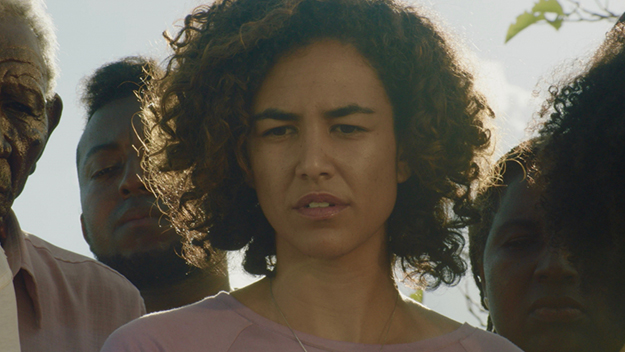
KMF: There is another important element. We haven’t spoken much about this in our interviews, but the Brazilian sertão is actually extremely white. For many, even for many Brazilians living in the South, it’s surprising to learn just how white the Northeast midlands are. We were ready to film in a mostly white town with its wonderful inhabitants, but then during scouting we came across a quilombo [a community historically created by runaway slaves].
We immediately noticed a very clear separation between the city that served as our base, and which was about 90 percent white, and the quilombo, which was entirely black. The two communities did not mix in any way. From then on, the unstated but absolutely crucial idea for our film was that Bacurau is a type of a “remixed quilombo”: a black community, a historical place of resistance, but with some white, indigenous, trans, and other inhabitants.
The matriarch who passes away in the film is then the matriarch of the quilombo—although we never specifically use this word.
And so you are evoking Brazil’s past rebellions—and quilombos as places of flight, but also of resistance.
JD: Precisely.
KMF: This is why the capoeira scene, which wasn’t originally in our screenplay but instead came directly from our actors, becomes so important. When some of our cast started dancing capoeira spontaneously on the set, we decided to film them. I confess that I wasn’t a fan of that scene at first, but after watching Night by John Carpenter—which in fact we knew very early on would be part of the film—I had the idea that perhaps if we joined the capoeira with just the sounds of feet and hands beating the rhythm, and then the music from Night—we would really have something. You hear the capoeira go on, but it is being drowned out by industrial sound.
JD: That moment—the industrial sound invading the scene—symbolizes the way that the place itself is being invaded by outsiders.
Ela Bittencourt works as a critic and curator in the U.S. and Brazil and consults for a number of international film festivals. She also runs the film site, Lyssaria.



